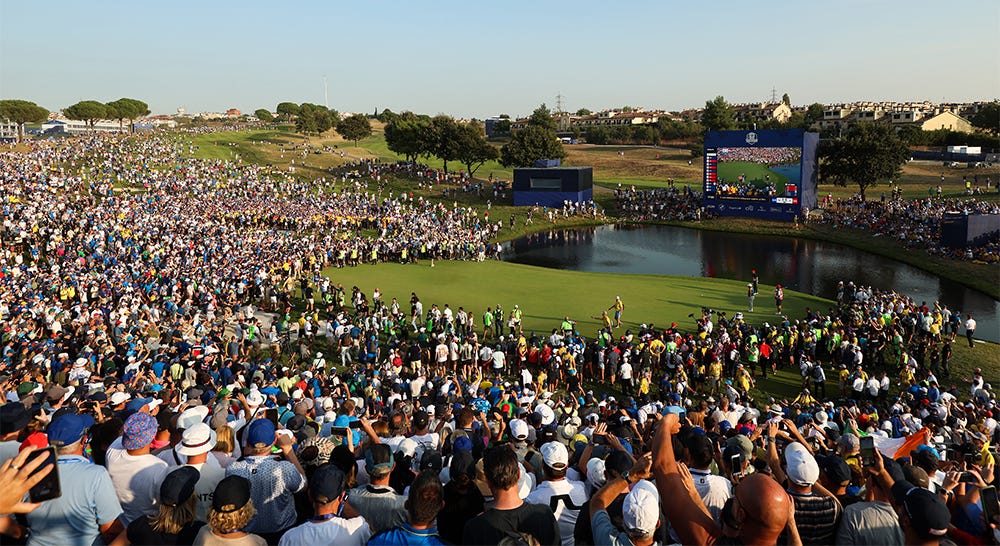Ryder Cup runneth over acceptable limits
$750 daily tickets at Bethpage won't win PGA of America favor from fans or players
PGA of America sees a lot of dollar signs swarming Bethpage like they did in Rome (Luke Walker/Getty Images)
All the money talk in golf is clearly having an adverse impact on the professional game. The riches being thrown at the top players in the game might have been justified in some circles, but it has gone beyond what is sustainable and it’s why the warring factions can’t quite figure out how to proceed.
Now comes word that it is going to cost a family of four $3,000 to attend just a single day of the Ryder Cup next year at Bethpage Black.
It’s reached the point of absurd.
Certainly it’s not the PGA of America’s fault that the PGA Tour and DP World Tour find themselves having to step up to the challenge presented by LIV Golf and its sovereign-wealth benefactor, the Public Investment Fund of Saudi Arabia.
But perhaps the organization that runs the Ryder Cup in the United States and also stages the PGA Championship might have read the room a bit better.
There is no way you are winning any kind of public relations battle charging $750 a ticket to attend one round of a golf tournament, no matter how big a ticket it might be or how much food and beverage (sans alcohol) you throw in.
Sure, the PGA has a right to reap a mighty profit off the event — it is a huge cash cow along with the PGA Championship that helps the organization fund its membership — and it’s arguably justified in charging top dollar in a huge metropolitan market such as New York City.
But the get-in price is more than double what it was last year in Rome and four times the amount it was in 2021 at Whistling Straits.
Yes, the fine print says those ticket prices include taxes and fees and all-you-can eat food and (non-alcoholic) beverages but we’re still talking easily a $500 return per person.
At 30,000 spectators per day for each of the three competition days, that is $15 million a day or $45 million over the course of those three days.
That doesn’t include the $255 per ticket for the Tuesday and Wednesday practice rounds, nor the $423 for Thursday. It doesn’t include parking. It doesn’t include alcohol. It doesn’t include merchandise sales.
And obviously it doesn’t include the even bigger revenue sources which are corporate hospitality and television rights fees.
With all of that, the Ryder Cup is a nine-figure revenue source.
And the players get a stipend plus a charitable donation of $200,000 in their name.
That, of course, is the other angle to this entire mess. How do you think some of those players who may or may not have an issue with no direct compensation feel about those who come to watch them play getting charged that kind of money?
What other sporting or entertainment event sees the participants do it for free?
Sure, athletes and entertainers do benefits or charitable events often. But the Ryder Cup is a competition where they keep score, where the result matters, where careers are often defined or maligned.
The idea that they should do this for free — just because they are well-compensated otherwise and it’s all about country and continent — seems about as profound as thinking college football players are no longer going to be compensated. Understand, doing it for nothing is the prevailing view among the masses. The argument for paying Ryder Cuppers is unpopular.
This issue has simmered for 25 years, all the way back to the 1999 Ryder Cup at Brookline, where Mark O’Meara (who many believe never became U.S. captain because of it) wondered why players weren’t paid and others such as David Duval, Tiger Woods and Phil Mickelson wondered where the money was going.
The controversy was quelled and players started getting charitable funds but it has always hovered beneath the surface. Charging $750 a ticket is not going to help.
The PGA of America’s championship director, Bryan Karns, did several interviews last week explaining what went into the price structure and how the organization came to its decisions. It clearly wasn’t done haphazardly, and there is a method to the madness, even if most are not going to buy it.
“We view ourselves as a Tier 1 event that’s on par with a World Series, or with an NBA Finals Game 7,” Karns told Sirius XM-PGA Tour Radio. “That was part of it.”
He also told Geoff Shackelford, who writes a golf newsletter for Substack, that the NYC’s high cost of doing business and accommodating some 50,000 people a day (including volunteers, media and security) were factors in the pricing structure.



